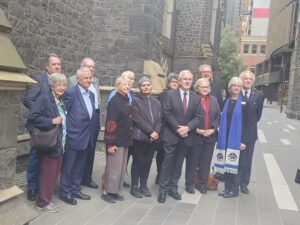
Kirralee Nicolle
3 November 2022
A disparity between numbers of ordained women and men in parish ministry means a lack of role models for women with a sense of calling, Melbourne clergy say.
The Archbishop in Council was recently charged by Synod with investigating the disparity in numbers of men and women clergy in full-time, stipended roles.
Mover of the motion Archdeacon the Venerable Jill McCoy said she believed that since women were underrepresented as vicars, young women who had a sense of vocation in the church might not see many role models in ministry.
“Women are not necessarily seen by lay and ordained people in their parishes as potential clergy,” Ms McCoy said.
Read more: Tereaza, Monica and Rebecca follow call to ministry
She said she had also noticed over the years that women tended to study part-time or online during their training, tended to be further advanced in their studies before they entered the vocational discernment process and were less likely to be offered full-time paid curacies.
“Where a guy may have had three or four placements before going into their curacy, a woman may have only had one or two,” Ms McCoy said. “That’s going to impact how they function as they begin their curacy, because they have a different experience base and a different sense of themselves in ministry.”
She said though 2022 marked 30 years of the ordination of women in Australia, it only signified one generation of women as ordained clergy.
“In the history of the church, it is but the blink of an eye,” Ms McCoy said.
Read more: Unaddressed burnout, heavy workloads amid ordination shortage
The motion requested the findings of research into the disparity be reported to Synod in 2023. It listed some of the avenues of investigation for the AiC as follows:
- The reasons why the average age for women at ordination is significantly higher than for men;
- Differences in the typical vocational discernment process, including
- age on entering theological education, and
- stage of theological education at which postulants enter the year of discernment;
- Women’s experience of accessible and appropriate models of ministry during their years of formation in ordained ministry;
- Obstacles to women being appointed as Vicars of parishes;
Ms McCoy’s motion was based on research by Colin Reilly, who has conducted quantitative research on the topic.
Read more: Clergy shortage, biblical marriage on Melbourne Synod agenda
Mr Reilly said his study found that across all Australian dioceses which permitted female clergy to be vicars, ordained women tended to be stationed in parishes which were further from the central cathedral than men.
Findings also showed that on average, women were ordained at an older age than men, and tended to take parishes in more difficult socio-economic areas.
Mr Reilly said that an analysis of the active clergy listed in the forthcoming The Anglican Church of Australia Directory 2022-23 shows that there are now four dioceses with equal or greater numbers of female to male clergy: Bunbury in WA, Gippsland in Victoria, Grafton in NSW and Willochra in SA. Overall, though, the proportion is 25% active female clergy in Australia.
“The thing I would like to see explored most is the reason for women being ordained later,” he said.
He said he wondered if delaying ordination was due to taking on ministry as a second career, or whether women deferred pursuing ministry due to raising families.
Read more: It’s our future, so how can we fit ministry formation to the 21st century?
Mr Reilly concurred with Ms McCoy that questions remained about how much women were being encouraged or inspired to pursue ministry roles.
“The thing that we don’t know much about is the extent to which women’s vocations are fostered,” he said.
The Reverend Canon Professor Dorothy Lee said she believed theology was behind the disparity between men and women in ministry.
“The one big obstacle to women taking a full role in leadership in the church is the so-called view of complementarianism,” she said. “There are some people who are very nervous about women having authority.”
Read more: Struggle continues despite 30 year milestone for women’s ordination
Professor Lee said the argument of those who believed in complementarian theology was based more in tradition than in Scripture. She said in her experience, parishioners who attended churches where women were not encouraged to lead did not necessarily agree with their church leaders.
“We have to nose out where the opposition is,” she said. “A lot of people in the pews don’t necessarily follow the party line.”
Mullum Mullum Anglican Ringwood vicar the Reverend Maria Brand-Starkey said that though her experience of ministry had been largely positive, others she knew had not been so fortunate. She said some women were more comfortable waiting for an invitation to the ministry than putting themselves forward.
“One of the things that I have seen is there are women who are keen, but they just get overlooked,” Ms Brand-Starkey said.
She said though the process of ordination was an important one, she felt that sometimes the many hoops to be jumped through meant young, vibrant candidates were lost.
“Sometimes the process can take so long that we miss out on the energy, vigour and passion of youth,” Ms Brand-Starkey said.
She said it was very important for both leaders and members of parishes to encourage young people to take charge within their church communities and foster their enthusiasm for ministry.
“Everyone in the pew has a ministry of encouragement,” Ms Brand-Starkey said.
For more faith news, follow The Melbourne Anglican on Facebook, Twitter, or subscribe to our weekly emails.








One Response